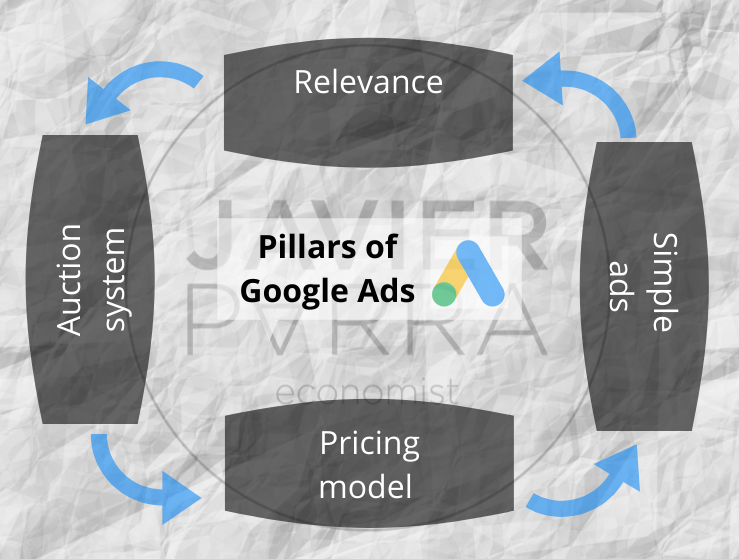The origins of Google Ads date back to 1996. The small company founded by Bill Gross, a company dedicated to online advertising whose name was Idealab (a company that unknowingly was destined to change digital advertising).
After two years of research, Bill Gross’s team created and launched GoTo.com, whose business model was that the advertiser placed an advert, which appeared in the search results that responded to the “consumer’s” search parameters. The user enters a request in the search window, and if the advertiser incorporated the terms of the request into their ad, it would be displayed.
Why GoTo.com worked
The success of the GoTo.com application was based on four pillars, pillars on which Google Adwords, which is known today as Google Ads, was later built:

1- Relevance and pay per click
The adverts appeared on GoTo.com because they were adapted to what users were looking for. These adverts were more relevant than others. Google Ads is an ad system that currently works on a pay-per-click basis, where the advertiser chooses the words that trigger the display of their ads. That is why we place GoTo.com as a key player in Google Ads origins.
Payment is made only when the user clicks on the displayed ad, thus ensuring that users only see ads relevant to their search and that advertisers only pay for customers interested in what they are offering.
Before PPC advertising came on the scene, the search results displayed were largely banner ads that were not responsive or tailored to the queries. In other words, results appeared for their queries but were not relevant to them, so many advertisers paid to be seen but did not generate conversions.
GoTo.com achieved this synergy between advertisers and users, showing ads that matched their search topic, which allowed both parties to achieve their goals 1- advertisers could attract audiences to their products and services and 2- users could find products and services that matched their needs.
2- The pricing model
In the beginning, advertisers paid for the mere fact of being shown, so they had to decide how many times they could be shown and pay accordingly (CPM, which could be translated as Cost Per Thousand Impressions), which resulted in online advertising needing a solid budget to sign the initial contract without being able to estimate the number of sales or visitors they would get in return. In other words, online advertising could only be afforded by organisations or companies with venture capital participation.
By moving to the PPC model, advertisers only paid if their ads were converted into traffic to their websites; with the release of monetary obligations, a new paradigm emerged in the world of digital marketing, i.e. it went from costing thousands of dollars a month to being able to run a campaign that cost €1 per month.
This new pricing model forced only relevant ads to be included in search results, which gave advertisers and search engines an impetus to work together to arouse users’ interest.
3- Simplification of ads
Thanks to the simplicity of GoTo.com, much of the complexity of running an online ad campaign was eliminated. Any advertiser could register their account, select keywords and create their ad in just a few minutes.
This is another reason why we can place GoTo.com as a fundamental element of the origins of Google Ads; it simplified the way of advertising so much that it was no longer necessary to pay commissions to advertising agents or sign contracts or make calls to advertisers. Any advertiser (however small or large their company) could experiment with Internet advertising on their own.
4- Auctions
GoTo.com decided that it would not be the advertisers themselves who would set the price for the display, but rather the advertisers themselves who would determine how much they were willing to pay for the ad, the highest position in the search results would be awarded to the one who was willing to pay the most.
Such was the impact of this system. In 2001, GoTo.com was awarded a patent for the “System and method for influencing the ranking position of search results generated by a computer network search engine”. This patent became the basis of the advertising techniques used in PPC. As search engines, users and advertisers developed ingenuity and entrepreneurship; the auction process became more complex.
These are the 4 pillars of GoTo.com that place it as a cornerstone in the origins of Google Ads, relevance, price, self-service capability and the position auction system.




